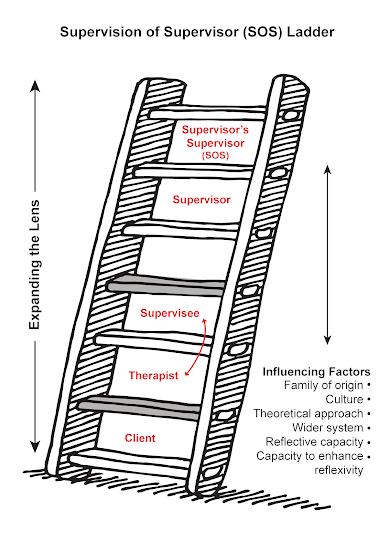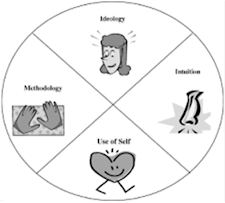Supervision of Supervision (SOS)
Supervision of Supervision
‘The purpose and process of supervision of supervision are similar to those of supervision. The aim is to make some of the unconscious conscious, to facilitate a containing and generative space where the clinician bringing their work is enabled to think more deeply about the dynamics occurring in another relationship….. (Power, 2013 p. 391)…. in essence providing containment.
Tasks of the supervisor's supervisor
One way to view the application of SOS is to consider the usefulness of this process…’why engage in supervision of supervision’?
Using the metaphor of a Supervision of Supervision (SOS) Ladder, the supervisor’s supervisor provides a meta-position to consider the dynamics of the therapeutic relationship. The supervisor of supervision provides a space for the supervisor to discuss and reflect on the therapist-client dyad with an aim to create distance and clarity regarding the client and their wider system. In a sense, the supervisor creates space and containment for thinking and thinking about what action is needed.
👉 Supervisor 👉 Therapist 👉 Client 👉 and so on and so on Supervision of Supervisor (SOS) Ladder - Image © Copyright Clinical Supervision Services |
Supervision of supervision provides a relational perspective using a ‘wider-angled lens’ (Mander, 1997) as there are four people (client, therapist, supervisor, supervisor of supervision) and three relationships (client and therapist), (therapist and supervisor); and (Supervisor and the Supervisor’s supervisor).
 As such the supervisor of supervision is required to move between client, supervisee and supervisor to understand and process clinical material that may have already been processed between the supervisor and the therapist. Power (2013) refers to this process as a ‘hall of mirrors’ that throws up new perspectives and insights.
As such the supervisor of supervision is required to move between client, supervisee and supervisor to understand and process clinical material that may have already been processed between the supervisor and the therapist. Power (2013) refers to this process as a ‘hall of mirrors’ that throws up new perspectives and insights.Supervision of ordinary work will also use reflection on process and review of therapeutic knowledge and skills but typically lacks the added relational perspective of the wider-angled lens. This lens allows for the zooming in and out, creating juxtaposition for analysis of processes and patterns in the work presented by the supervisee to the supervisor and in the work presented by the supervisor’s supervisor.
The opportunity to reflect on parallel process
Supervision provides the opportunity to stop, think and reflect on practice. It should be a distinct time to receive feedback and guidance to facilitate problem solving and set goals for action.Haber et al’s (2009) use of the mnemonic "Head-Hands-Heart-Nose" - Head (theory) Hands (techniques/methodology), Heart (use of self) and Nose (intuition) - explores the therapist’s developmental skills and also ways of conceptualising clinical material.
Extending this model to SOS, the supervisor’s supervisor can use this framework to explore the specific needs for both the supervisor and the supervisor’s supervisee.
For example:
1. Does the supervisor need help considering the specific skills of the supervisee?
2. Review the skills of assessment, structuring the therapeutic relationship, setting tasks in treatment and problem solving
3. How will the supervisor apply this in practice with the supervisee? What model will s/he use to teach skills to manage the therapeutic context?
4. In SOS the Supervisor helps the supervisee to reflect on how s/he has assessed the specific developmental needs of the supervisee and review the clinical tasks in action. At this stage the supervisor’s supervisor is focused on ensuring the supervisor can facilitate the supervisee’s skills in the clinical room from a relational perspective.
Head:
1. Moving to the next developmental level the SOS supervisor expands the lens to help the supervisor review theoretical frameworks that the supervisee is using
2. There is a focus on how the supervisee uses theory to conceptualise and intervene in cases and how this is communicated in the supervision session
3. What models of supervision practice does the SOS supervisor use to facilitate this meta-reflection and apply in-action and for-action?
Heart:
1. At this stage the supervisor’s consultant takes the wide-angled lens to consider how the supervisor facilities the therapist’s use of self in the therapeutic process – to look at theoretical explanations, useful reframes, hypotheses and countertransference
2. Similarly, the supervisor’s consultant needs to explore the interplay of the supervisor’s reactions to the material – what s/he brings to the discussion and reflection on the critical issues presented.
Nose:
1. The supervisor’s consultant helps the supervisor notice and use their experience (theoretical and practical) to explore and use clinical hypotheses (hunches)
2. Extending this to the supervision room of the therapist, the SOS consultant uses reflective questioning to develop the supervisor consider how to help the therapist develop new insight through ongoing reflectivity
3. The SOS consultant expands the lens beyond in -session reflection to future focused action.
Overall, the SOS consultant needs to look at how the information is presented in supervision – what information is provided about the supervision context and how the information is communicated by the therapist to the supervisor and then onto the SOS supervisor. The seven eyed model provides a framework to explore the different layers that exist in clinical and supervisory supervision. |
Questions to consider
- What is the structure and focus of supervision?
- Does it influence the manner in which the supervisee presents material?
- How is it facilitative and non-judgmental to encourage supervisee openness in the session?
- Does the style of questioning in supervision then translate to an open and warm manner in the therapy session?
- How does the supervisor’s consultant identify AND attend to tricky problems of either the supervisee OR client that might have escaped the supervisor’s attention? What if the issues are ethical and need follow up?
- How can the supervisor’s consultant open an interpretative dialogue to unpack further reflection processes for the supervisor to help foster supervisee creativity/openness and reflection (which in turn then helps the client)?
When to use supervision of supervision
1. Supervision of supervision as a container
At times therapists need ‘holding’ to manage emotions either by what is occurring in the therapeutic context or in the workplace. Supervisors need to help the supervisee identify and manage these emotions. SOS offers a meta-position to reflect on the dynamics of the context: to provide the supervisor with an opportunity to discuss the material being presented in supervision and to uncover other ‘unconscious or conscious’ issues that might need further addressing
(An example might be the supervisor who gets ‘caught up’ in discussions about workplace politics; noticing s/he is taking sides or feeling for the supervisee in their presentation)…
2. When the supervision session goes wrong
In this context the supervisor might bring to the SOS session examples of supervision sessions that did not go well – for example, the resistant supervisee/the angry supervisee etc., In this context SOS will help the supervisor see the supervisory relationship from different perspectives (client – relational – wider system etc.)
3. When the supervisor needs help with ethical/legal issues
Here the SOS supervisor will help the supervisee with specific questions (what are the ethical issues here? What are my legal responsibilities? How do I help the supervisee follow through with xxx….? In this context it might be a focus on education and helping the supervisor identify how to work with complex presentations or giving advice in supervision
4. When the supervisor needs help identifying and managing transference and countertransference
Transference-countertransference issues are often related to problematic areas in supervision (point2) – here the SOS supervisor takes a wide angled lens to help the supervisor review wider systems issues/relational issues/client issue, Here the SOS supervisor reviews parallel processes in client-therapist….therapist- supervisor…..supervisor – supervisor’s supervisor contexts.
Conducting the Supervisor’s Supervision Guidelines
1. What is the question/s for SOS?
a. What do you need help with? Spell out all aspects of the presentation considering the client, the supervisee, wider systems
b. Is your question (supervisor) different to what the supervisee has asked of you?
(Look for closeness/distance/alliances/boundaries/triangles or lack of; hierarchy; explicit and implicit rules – of both therapy and supervision; explicit and implicit ‘power’ in all relationships – e.g. reporting/legal)….use the visual map to explore patterns
https://lindsaybraman.com/genogram-key/
a. Supervisor conceptualisation/formulation (do theoretical explanations match)
a. Strengths
b. Areas of need?
c. Response of the therapist/your (supervisor) response to the supervisory material
Concluding comments
- In SOS the focus is on the relationship in the supervision room (rather than the relationship in the therapy room – lower tier reflection occurs between therapist and supervisor) ….look out for how and what the supervisor tells you about the supervision session.
- What is the ‘real question’ for SOS…. that is, what is the conscious question (e.g. I don’t know how to answer this question of my supervisee?) Alongside the unconscious question (e.g. I worry about my supervisee’s skills or am I good enough to provide the supervision that is needed? Or how do I execute my power in the supervisory relationship to provide more effective and meaningful feedback?
- SOS needs an effective alliance to enable deep and meaningful reflection
- Create space and time either as a separate SOS session or a designated and named time in your supervision session
- Keep the focus on the supervisor seeking supervision and work towards developing insight to notice and improve their relational capacity for reflection….reflection on action for action….. By doing so, the SOS supervisor will encourage self-reflection in action for both supervisee and supervisor alike.
- Christine Senediak
Director, Clinical Supervision Services and Sydney Family Therapy Training Institute
July 2022
Christine can be contacted through her website at:
www.clinicalsupervisionservices.com.au
References
Aten, J., Madson, M., & Kruse, S. (2008). The Supervision Genogram: A tool for preparing supervisor-in-training, Psychotherapy: theory, Research, Practice, Training, 45, 111 – 116.
Haber, R., Hawley, L (2004). Family of Origin as supervisory consultative resource, Family Process, 43, 373 – 390.
Haber, R., Marshall, D., Cowan, K., Vanlandingham, A., Gerson, M., & Fitch, J. C. (2009). Live supervision of supervision: Perpendicular interventions in parallel processes. The Clinical Supervisor, 28, 72–90.
Jensen, P. (2016). Mind the map: Circular processes between the therapist, the client and the therapist’s personal life. In A. Vetere & P. Stratton (Eds.), Interacting selves: Systemic solutions for personal and professional development (pp. 33–50). London: Routledge.
Ladany, N., Constantine, M., Miller, K., Erickson, C., & Muse-Burke, J. (2000). Supervisor countertransference: A qualitative investigation into its identification and description. Journal of Counselling Psychology, 47,102–115.
Mander, G. (2002). Supervision of supervision: Specialism or new profession? In C. Driver & E. Martin (Eds.), Supervising psychotherapy (pp. 132–139). London: Sage.
Power, A. (2013). Supervision of supervision: How many mirrors do we need? British Journal of Psychotherapy, 29, 389–404.






